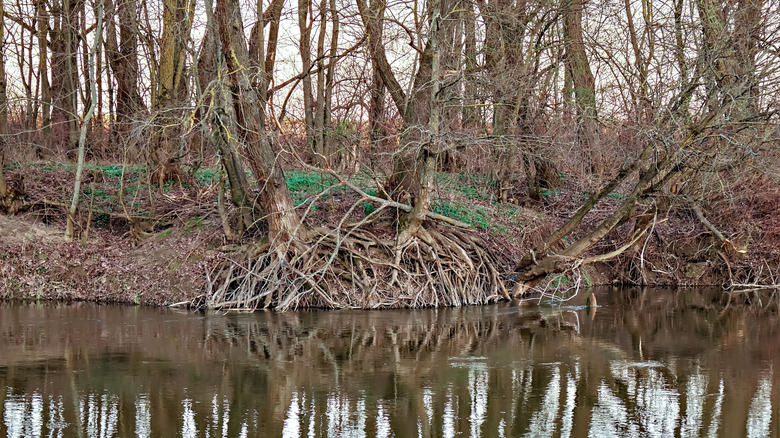The Beautiful Tree HGTV's Erin Napier Says Is 'Magic'
HGTV's Erin Napier, co-host of the Southern renovation show "Home Town," is no stranger to big landscape fixes, and in a season nine episode, a pondside cottage project had some of the messiest trees that you don't want to plant in your yard: sweetgums (Liquidambar styraciflua). Ben Napier, co-host of "Home Town" and Erin's husband, lamented the loss of these mature, yet messy trees. But true to the show's message of heartfelt restoration, he asserts, "if we take one down, we always want to plant another one." While an oak tree was the main affair, a weeping willow caught Ben Napier's eye.
Perfect for damp environments like pond edges, weeping willows (Salix babylonica) are both a practical choice for the kind of setting the Napiers were working with in the episode, as well as an aesthetic choice that creates a magical retreat. "It just makes a pond in my mind," friend and frequent helping hand, Josh Nowell, remarked on the tree. Erin Napier wholeheartedly agreed, pointing out the willow planted pondside during the renovated house's big reveal: "A willow tree here by the water, because — magic."
Benefits of a weeping willow
Hardy in USDA Zones 6 to 8, weeping willows can grow up to 50 feet tall, with a similarly wide spread. They love loamy or sandy soil types and prefer moist environments, thriving in wet soil — hence their success when growing alongside ponds and lakes. Other than aesthetic value, the weeping willow has other great benefits, including acting as a prime host plant for viceroy butterfly larvae and offering a rich food source for mature butterflies. As one of the first trees you'll see get its color back in the spring, willows are a beautiful reminder of the seasons. As early-season bloomers, willows even support certain bee species!
When planted on slopes, willows can also help mitigate erosion on lakes and ponds, helping keep the ground stable. Deer-resistant willows are also known to absorb pollutants from nearby waterways and the surrounding soil, acting as a natural filter. Given their penchant for moisture, weeping willows can also soak up excess water in yards, helping prevent oversaturation. And for more manufactured waterways that may look and feel a little, well, stoic, weeping willows lend a softer, more romantic element, making the space feel more organic and natural than if it were kept bare.
Factors to be mindful of when planting willows
There are some things to be mindful of when adding a willow tree to your landscaping, however. First, you shouldn't plant willows too close to your home, and avoid planting near underground sewer or water lines or septic tank fields. Since they love moisture so much, willow roots will grow outwards and reach for these sources of water, possibly causing significant damage to these structures. Willow roots are quite aggressive — and even considered invasive in some areas — spreading up to three times the length of the trunk to the canopy; they can disrupt construction features if you're not careful. Willows are also susceptible to breakage, so be sure any additional structures are well clear of the tree's canopy.
As for maintenance, willows are deciduous, meaning they'll drop their leaves in copious amounts in the fall, which may make them a less desirable traditional landscaping feature for those seeking low-maintenance plants. Not only do they drop leaves, but also dry pods which contain cotton-like seeds that disperse during the late spring to early summer months. Thus, clean up can be quite a chore. However, if your property sits on water, and you're looking to craft a charming, romantic environment around — but not too close to — your home, then a weeping willow may be the Erin Napier–approved, "magical" choice for you despite the upkeep.


